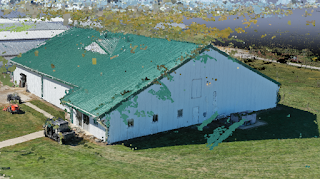Austin
Sullins
AT
419
Intoduction:
All of last semester my group work nonstop
trying to find a more efficient way to 3D map all sorts of buildings. We flew
over 10 flights gathering data and have built over 5 3D models. With most of
our data and research done we are starting to prepare ourselves for the
publication aspect of this project. This intern is by far the least interesting
part of this entire project, BUT the absolute most important! This is the part
of the project that all of you who are reading this will see. This is the part
that you will judge us upon. This is the part that will be the deciding factor
of whether we get a job in this industry or not, and that is why we are putting
in so much time and energy into the decision of doing a white paper or doing a
pier research paper.
Some of the main differences between
a white paper and a peer review is what you are trying to accomplish! If you
are trying to do more of a sales and pitch then a white paper is what you would
want to go with. If you are looking to have someone read your material to lean
or teach with then a peer review would be a better fit. I personally have
written a few white papers so I believe that is the path that my team should go
down. However, after the research I have done and what we are really wanting
from this project the peer review is starting to sound like it could be a good
path to go down and here is why.
First thing I notice right off the
bat is that the structure is completely different. It reminds me of military
writing how everything is flush to the left margin unless it is an extended
note of that previous statement. Another thing is the utilization of diagrams
and charts. This is something used mostly for data in peer review and not
really a thing in normal literature. The reading style is very easy to follow
and flows with the process that they are trying to complete. I do believe that this
is a good process for certain things that you are trying to get done. This
style would work a lot better than a normal paper, but I don’t believe this is
the path our group should follow.
Conclusion:
Yes, we are trying to “sell” ourselves to
companies and possible employers, but I believe that isn’t what this project is
about anymore. I believe that is has grown more into testing and stretching the
bounds of what this industry knows and is comfortable with! The thought of
accurate 3D mapping taking a matter of minutes and as few as 5 pictures seemed
impossible to us and, from what I’ve gathered from talking to companies, the
industry as well. Yet, our team has been able to cut down this process by over
half and we aren’t even experts in everything we need to be to make the process
the fastest it could be. Along with that we are asking questions that haven’t
really been asked before. I had a conversation with multiple people from ESRI
about our project and what we need to make this process more efficient and the
people I had talked to had never thought about the things our team was doing.
They had never thought about taking an actual CAD blueprint of a building and
overlaying pictures on top of it. They never thought to look into how this
could turn building inspections into a process that takes minutes instead of days.
All of this added together is telling me that a peer review paper is the way
this group needs to go to open more doors up for not only ourselves, but for
this research as well.
Work Cited
“Cultural
Confusion: White Papers vs. Peer Review.” Digital World Biology, 30 Oct. 2017,
digitalworldbiology.com/archive/cultural-confusion-white-papers-vs-peer-review.
Dorard, Louis.
“The Problem with White Papers.” Medium, PAPIs Stories, 17 Sept. 2018,
stories.papis.io/the-problem-with-white-papers-d82c3678f9e7.
Kelly, Jacalyn,
et al. “Peer Review in Scientific Publications: Benefits, Critiques, & A
Survival Guide.” EJIFCC, The Communications and Publications
Division (CPD) of the IFCC, 24 Oct. 2014,
www.ncbi.nlm.nih.gov/pmc/articles/PMC4975196/.
Ordway, Denise-Marie.
“White Papers, Working Papers, Research Articles: What's the Difference?” Journalist's Resource, 4 May 2018,
journalistsresource.org/tip-sheets/research/working-papers-research-articles/.
Purdue Writing
Lab. “Purpose and Audience // Purdue Writing Lab.” Purdue Writing Lab,
owl.purdue.edu/owl/subject_specific_writing/professional_technical_writing/white_papers/index.html.













